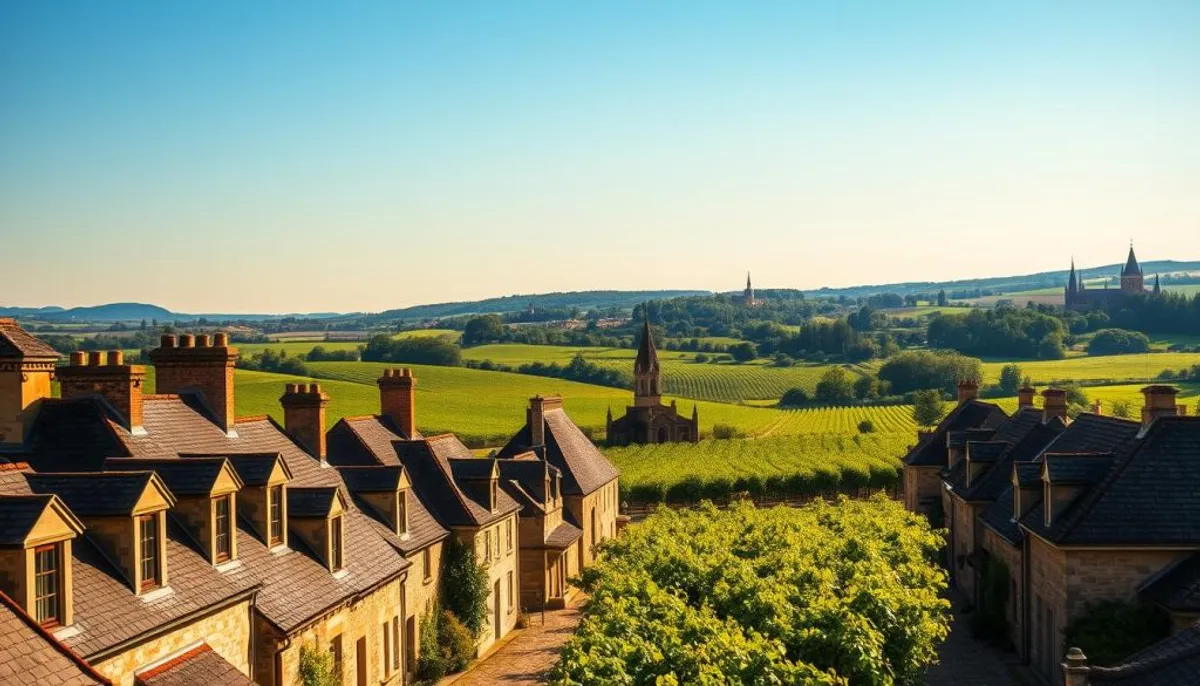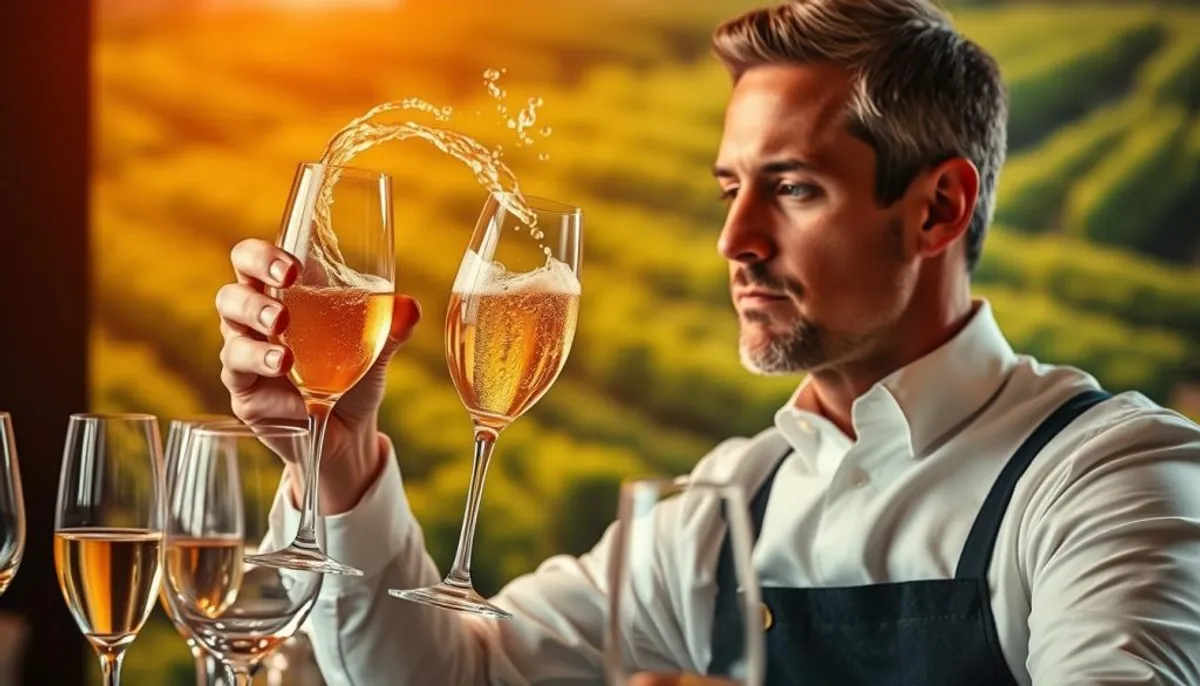Embark on a journey into the realm of Franse mousserende wijn with champagne uit champagnestreek. This effervescent gem embodies the quintessence of France’s most revered wine district. The Champagne region is celebrated for its storied past and unparalleled mastery in the art of sparkling wine production.
Champagne uit champagnestreek distinguishes itself through its distinctive production techniques and rigorous quality standards. These wines must age for a minimum of 15 months for non-vintage and 36 months for vintage varieties. This extended aging period is pivotal in developing the intricate flavors and delicate bubbles that champagne aficionados cherish.

The crafting of champagne uit champagnestreek is a labor-intensive endeavor. Grapes undergo a double fermentation, with the second fermentation occurring within the bottle. This traditional approach distinguishes champagne from other sparkling wines. The outcome is a Franse mousserende wijn of unmatched quality and distinctiveness.
Key Takeaways
- Champagne uit champagnestreek undergoes strict aging requirements
- The traditional method involves second fermentation in the bottle
- Sugar content determines champagne sweetness categories
- Reserve wines play a crucial role in non-vintage blends
- The term “methode champenoise” is exclusive to the Champagne region
Understanding the Heritage of Champagne Region
The Champagne region is renowned for its rich history, mirroring the effervescence of its celebrated sparkling wine. Situated in northeastern France, it has been producing exceptional wines since the early 17th century. This has garnered it international acclaim for its distinctive terroir and traditional winemaking techniques.
The Historical Significance of AOC Champagne
AOC champagne stands as the epitome of sparkling wine craftsmanship. In 2015, UNESCO designated key areas of the Champagne region as World Heritage Sites. These include the vineyards of Ay and Mareuil-sur-Ay, Hautvillers village, and Avenue de Champagne in Epernay. This acknowledgment underscores the region’s evolution from small-scale artisanal production to a significant agro-industrial force.
The Role of Méthode Traditionnelle
The méthode traditionnelle is central to champagne production. This ancient method involves a second fermentation in the bottle, resulting in the wine’s characteristic bubbles and complex flavors. Renowned houses like Moët & Chandon have refined this technique, offering tours that highlight their expertise.
Terroir’s Impact on Champagne Production
The terroir of the Champagne region is pivotal in defining the essence of AOC champagne. The area’s chalky soils, cool climate, and undulating terrain imbue the grapes with unique flavors. Visitors frequently extol the excellence of tours at estates like Moët & Chandon, highlighting the meticulous care of cellars and the profound knowledge imparted by guides.
Exploring Premier Champagne uit Champagnestreek
The Champagne region is a treasure trove of prestigieuze champagnehuizen, each with its own distinct charm. Among these, Champagne Devenoge shines brightly, celebrated for its symbolic champagnes and unwavering dedication to quality.
Champagne Devenoge is renowned for its exceptional champagnes, crafted in unique bottles like the Louis XV and Princes Champagne. These creations are true embodiments of luxury and tradition. The house’s skilled oenologists adhere to strict quality standards, carefully selecting grapes from the most prestigious vineyards and employing extensive aging techniques.
Champagne Devenoge’s cellar is one of the largest in the region, a vast underground space filled with bottles aging to perfection. The champagnes’ low sugar dosage highlights the terroir’s true essence, delivering a crisp and refined taste experience.
Other prestigieuze champagnehuizen in the area offer equally captivating experiences. From ancient maisons to modern boutique producers, the Champagne region is a melting pot of champagne uit champagnestreek. Each house brings its own unique perspective to champagne production, ensuring every glass is a testament to tradition, craftsmanship, and excellence.
Distinguished Grand Cru Villages and Their Significance
The Champagne region is home to 17 officially classified grand cru champagnedorpen, accounting for about 17% of the total vineyard area. These esteemed villages are responsible for producing approximately 30% of all Champagne. This highlights their critical role in the industry.

Notable Grand Cru Champagne Villages
Ambonnay, Bouzy, and Aÿ are among the grand cru champagnedorpen, distinguished by their exceptional terroir champagnestreek. These villages are celebrated for their Champagnes, which exhibit distinct characteristics. These are a direct result of their unique growing conditions.
Unique Characteristics of Each Village
Each grand cru village contributes specific traits to its Champagnes. For example, Ambonnay is famous for its full-bodied Pinot Noir. In contrast, Cramant is known for its elegant Chardonnay-based Champagnes. The average age of vines in these villages is around 30 years, adding to the wine’s complexity.
Soil Composition and Its Effects
The terroir champagnestreek is pivotal in shaping the flavor profiles of Grand Cru Champagnes. The chalky subsoil prevalent in many villages ensures excellent drainage. This imparts a distinctive minerality to the wines.
| Village | Predominant Grape | Soil Type | Characteristic |
|---|---|---|---|
| Ambonnay | Pinot Noir | Chalk, Limestone | Full-bodied, Powerful |
| Cramant | Chardonnay | Pure Chalk | Elegant, Mineral-driven |
| Aÿ | Pinot Noir | Chalk, Clay | Rich, Fruity |
Traditional Champagne Production Process
The champagneproductie proces, known as méthode traditionnelle, is a meticulous art form. It begins with carefully harvesting grapes at peak ripeness. These grapes are then gently pressed to extract their juice, which undergoes its first fermentation in tanks or barrels.
After this initial fermentation, winemakers blend different base wines to create the desired flavor profile. This blend is bottled with a mixture of sugar and yeast, triggering a second fermentation inside the bottle. This crucial step creates the signature bubbles and complex flavors champagne is known for.
The bottles are then aged on their lees, allowing the wine to develop richness and depth. Following this, the bottles undergo riddling, where they’re gradually tilted and rotated to collect sediment in the neck. The neck is then frozen and the sediment removed in a process called disgorgement.
Lastly, the dosage – a mixture of wine and sugar – is added to balance the champagne’s acidity. The bottle is then corked, wired, and left to rest before release. This intricate méthode traditionnelle ensures each bottle of champagne uit champagnestreek is a testament to craftsmanship and tradition.
Boutique Champagne Houses Worth Discovering
Delve into the hidden treasures of Franse mousserende wijn within the Champagne region’s heart. These boutique champagne houses present unique experiences for those passionate about authentic champagne uit champagnestreek.
Champagne Jacquinot & Fils in Epernay
In Epernay, Champagne Jacquinot & Fils extends a warm welcome to its visitors. This family-owned estate is renowned for its friendly, non-commercial tours. These tours offer an intimate glimpse into the champagne-making process. Guests are treated to personalized tastings and can acquire exceptional champagne at fair prices.
Michel Fagot in Rilly-la-Montagne
In the picturesque village of Rilly-la-Montagne, Michel Fagot’s small champagne house impresses with its hospitality. The host warmly shares the intricacies of their champagne production, providing a genuine taste of champagne uit champagnestreek.
A. Lété in Damery
A. Lété in Damery is celebrated for its commitment to craftsmanship and tradition. Visitors are treated to an exceptional tasting amidst the walled vineyard. This experience immerses them in the rich heritage of Franse mousserende wijn production.
| Champagne House | Location | Unique Feature |
|---|---|---|
| Jacquinot & Fils | Epernay | Non-commercial tours |
| Michel Fagot | Rilly-la-Montagne | Warm hospitality |
| A. Lété | Damery | Walled vineyard tasting |
These boutique champagne houses offer a genuine look into the world of champagne uit champagnestreek. By visiting these smaller producers, wine enthusiasts can uncover the artistry behind Franse mousserende wijn. They take home unique memories of their Champagne region adventure.
The Art of Champagne Tasting
Mastering the art of tasting Franse mousserende wijn, notably champagne uit champagnestreek, significantly enhances your appreciation for this exquisite beverage. We will explore professional techniques, flavor profiles, and food pairings to elevate your champagne experience.
Professional Tasting Techniques
To fully appreciate champagne, engage all your senses. Begin by observing the color and bubbles. Swirl gently to release aromas. Take small sips, allowing the champagne to coat your palate. Note the initial taste, mid-palate flavors, and finish.
Understanding Flavor Profiles
Champagne flavors vary based on grape varieties, aging, and production methods. Common notes include citrus, apple, brioche, and nuts. The Côte des Blancs region, known for Chardonnay grapes, often produces champagnes with floral and mineral notes.

Food Pairing Suggestions
Enhance your champagne uit champagnestreek experience with perfect food pairings. Light, crisp champagnes pair well with seafood, while fuller-bodied ones complement richer dishes. Consider these pairings:
| Champagne Style | Food Pairing |
|---|---|
| Brut Nature | Oysters, sushi |
| Blanc de Blancs | Grilled fish, goat cheese |
| Rosé Champagne | Salmon, berry desserts |
| Vintage Champagne | Roasted poultry, aged cheeses |
Remember, tasting champagne is a personal journey. Experiment with different Franse mousserende wijn to discover your preferences and perfect pairings.
Essential Grape Varieties in Champagne Production
The druivenrassen champagne are pivotal in the creation of the renowned sparkling wine. Within the champagne appellation, three primary grape varieties stand out: Chardonnay, Pinot Noir, and Pinot Meunier. Each variety brings distinct qualities to the blend, resulting in the complex flavors and aromas champagne is known for.
Chardonnay contributes elegance and finesse to champagne, while Pinot Noir adds body and structure. Pinot Meunier introduces fruitiness and roundness. The combination of these grapes varies among producers, leading to a variety of champagne styles.
For instance, Philipponnat Champagne Royale Reserve Brut NV is composed of 65% Pinot Noir, 30% Chardonnay, and 5% Pinot Meunier. This blend undergoes malolactic fermentation and ages on lees for about three years. It results in a well-balanced champagne with a dosage of 8 g/l sugar.
Champagne houses also produce single-varietal wines. Blanc de Blancs, made entirely from Chardonnay, offers crisp, citrusy notes. Blanc de Noirs, crafted from red grapes (Pinot Noir or Pinot Meunier), delivers a fuller-bodied champagne with red fruit flavors.
The art of blending these druivenrassen champagne within the champagne appellation guidelines allows winemakers to create a wide range of styles. From light and refreshing to rich and complex, this diversity ensures champagne remains a versatile and beloved sparkling wine worldwide.
Planning Your Champagne Tour Experience
Embarking on a journey to explore champagne uit champagnestreek necessitates meticulous planning. The Champagne region, segmented into North and South, presents over 300 champagne houses to uncover. Let’s explore the key elements for an unforgettable tour.
Best Times to Visit
The ideal travel window for the Champagne region extends from April to mid-October. September, with its harvest season, is a peak time filled with vibrant events. This period allows you to observe the vineyards’ and prestigieuze champagnehuizen’s frenetic activity.
Booking Private Tastings
Reserve your spot at esteemed champagne houses in advance. G.H. Mumm offers a 1.5-hour guided tour with one glass of champagne for €28, while Vollereaux provides a 1-hour tour with three tastings for €17. For a distinctive experience, Vincent D’Astrée’s tour, showcasing diverse champagne styles, is worth considering.
Transportation Options
The Champagne region features approximately 700 kilometers of designated champagne routes. Renting e-bikes offers a relaxed tour through scenic vineyards. For those seeking comfort, car rentals or organized tours are viable options. Ensure to book accommodations in key locations like Reims, Épernay, or Troyes for seamless access to prestigieuze champagnehuizen.
With these guidelines, you’re prepared to embark on a profound champagne tour experience. You’ll be fully immersed in the world of champagne uit champagnestreek.
Prestigious Champagne Houses and Their Offerings
The champagne appellation is a rich tapestry of prestigieuze champagnehuizen, each with its own unique story and signature style. These revered establishments have shaped the identity of champagne for centuries. They blend tradition with innovation, creating exceptional sparkling wines.
Historical Maisons
Pommery, Bollinger, and Mercier are pillars of champagne heritage. Pommery, founded in 1858, pioneered the Brut style. Bollinger, established in 1829, is known for its full-bodied champagnes. Mercier, dating back to 1858, brought champagne to the masses with its approachable offerings.
Modern Innovation
Today’s prestigieuze champagnehuizen embrace cutting-edge techniques while honoring tradition. They experiment with sustainable viticulture, precision harvesting, and advanced fermentation methods. This enhances quality and consistency. Some houses now offer zero-dosage champagnes, catering to evolving consumer preferences.
Exclusive Collections
For connoisseurs, these champagne houses craft limited edition cuvées. Bollinger’s Vieilles Vignes Françaises, produced from pre-phylloxera vines, is highly sought after. Pommery’s Cuvée Louise represents the pinnacle of their craftsmanship. These rare offerings embody the essence of luxury within the champagne appellation.
| Champagne House | Signature Style | Exclusive Cuvée |
|---|---|---|
| Pommery | Brut | Cuvée Louise |
| Bollinger | Full-bodied | Vieilles Vignes Françaises |
| Mercier | Approachable | Eugène Mercier |
Purchasing and Exporting Guide
Embarking on the journey to acquire champagne uit champagnestreek is an exhilarating endeavor. Many producers engage in direct sales, offering a plethora of unique Franse mousserende wijn options. When selecting your champagne, it’s essential to consider several factors. These include the vintage, the grape blend, and the dosage. Each of these elements significantly influences the flavor profile and overall quality of your chosen bottle.
The process of exporting champagne necessitates meticulous planning. Ensuring proper documentation is paramount for seamless international shipping. The use of temperature-controlled containers is vital to safeguard the delicate bubbles during transit. It’s also imperative to familiarize yourself with the customs regulations of your destination country. Import laws regarding alcoholic beverages, including champagne uit champagnestreek, can vary significantly.
Are you prepared to bring a piece of France into your home? Visit https://champagne-export.com for a personalized quote. Their team of experts is ready to assist you, ensuring your Franse mousserende wijn arrives in pristine condition. Whether you’re a collector or planning a memorable event, they will facilitate your exploration of the world of champagne uit champagnestreek with unparalleled ease.
RelatedRelated articles



